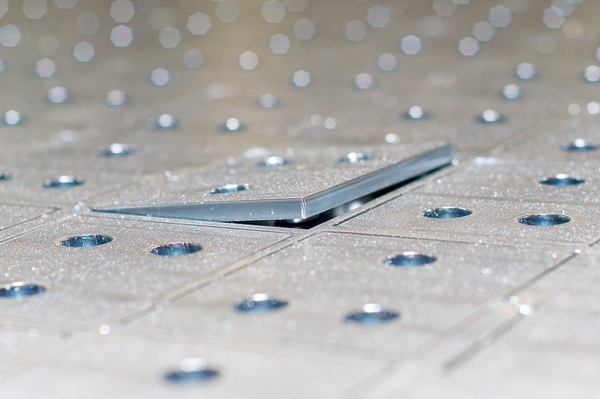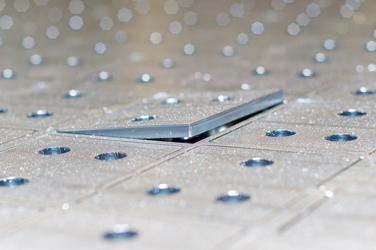Are you looking for an efficient and effective way to cut stainless steel? Look no further than plasma cutting. With its precision and versatility, plasma cutting has become a popular choice for fabricators and DIY enthusiasts alike. In this article, we will delve into the world of plasma cutting stainless steel and explore its benefits, techniques, and applications.

Photo by 858265 on Pixabay
What is plasma cutting?
Plasma cutting is a process that utilizes a high-temperature, ionized gas to melt through stainless steel, resulting in clean and smooth cuts. The intense heat generated by the plasma arc allows for precision cutting, making it ideal for intricate designs and complex shapes. Unlike traditional cutting methods, plasma cutting does not rely on physical contact with the material, which reduces the risk of distortion or warping.
The key component of plasma cutting is the plasma cutter, which consists of a power source, gas supply, and torch. The power source generates an electrical arc that ionizes the gas, forming plasma. The plasma is then forced through a small nozzle at high velocity, creating a concentrated and powerful jet of plasma that can cut through stainless steel with ease.
Advantages of plasma cutting stainless steel
Plasma cutting stainless steel offers several advantages over other cutting methods. Firstly, it provides a fast and efficient cutting solution. The high temperature of the plasma arc allows for rapid cutting speeds, reducing production time and increasing productivity. Plasma cutting produces clean and precise cuts, minimizing the need for further finishing or post-processing.
Another advantage of plasma cutting stainless steel is its versatility. The plasma cutter can be used to cut stainless steel of varying thicknesses, from thin sheets to thick plates. This flexibility makes plasma cutting suitable for a wide range of applications, including automotive, aerospace, construction, and fabrication.
Furthermore, plasma cutting is a cost-effective option. Compared to laser cutting, plasma cutting equipment is generally more affordable, making it accessible to a wider range of users. Plasma cutters also have lower operating costs, as they consume less energy and require minimal maintenance.
Safety precautions for plasma cutting stainless steel
While plasma cutting is a safe and efficient method, it is important to take proper safety precautions when working with stainless steel. Here are some key safety tips to keep in mind:
- Wear appropriate personal protective equipment (PPE) such as safety glasses, gloves, and a welding helmet with a shaded lens to protect your eyes from the intense light produced during plasma cutting.
- Ensure proper ventilation in your workspace to remove fumes and gases generated during the cutting process. Use a fume extraction system or work in a well-ventilated area to prevent the inhalation of harmful substances.
- Keep a fire extinguisher nearby and be prepared for potential fire hazards. Stainless steel can generate sparks during plasma cutting, so it is essential to have a fire safety plan in place.
- Inspect your equipment regularly and ensure that it is in good working condition. Faulty or damaged equipment can increase the risk of accidents, so it is important to perform routine maintenance and repairs as needed.
By following these safety precautions, you can ensure a safe and secure plasma cutting experience.
Equipment and materials needed for plasma cutting stainless steel
To perform plasma cutting on stainless steel, you will need the following equipment and materials:
Plasma cutter: Choose a plasma cutter that is suitable for cutting stainless steel. Consider factors such as power output, cutting capacity, and ease of use.
Gas supply: Plasma cutters require a gas supply to create the plasma arc. The most commonly used gases for cutting stainless steel are compressed air and nitrogen.
Consumables: Plasma cutting consumables include electrodes, nozzles, and shields. These components wear out over time and need to be replaced regularly for optimal performance.
Safety equipment: As mentioned earlier, personal protective equipment (PPE) such as safety glasses, gloves, and a welding helmet with a shaded lens are essential for safety during plasma cutting.
Stainless steel sheets or plates: Choose the appropriate thickness and grade of stainless steel for your project. Ensure that the material is clean and free from any contaminants that could affect the cutting process.
Having the right equipment and materials will ensure that you can achieve clean and precise cuts in stainless steel.
Tips for achieving clean and precise cuts in stainless steel
To achieve clean and precise cuts in stainless steel using plasma cutting, consider the following tips:
Set the correct cutting parameters: Adjust the cutting speed, amperage, and gas flow rate according to the thickness and type of stainless steel you are cutting. Refer to the manufacturer’s recommendations for the optimal settings.
Maintain a consistent standoff distance: Keep the plasma torch at a consistent distance from the workpiece throughout the cutting process. This ensures a steady and stable arc, resulting in clean and uniform cuts.
Use a guide or template: If you need to make intricate or repetitive cuts, use a guide or template to ensure accuracy. This will help you maintain the desired shape and dimensions of the cut.
Clean the stainless steel surface: Before cutting, ensure that the stainless steel surface is clean and free from any contaminants or debris. This will prevent interference with the plasma arc and help achieve better cutting results.
Practice proper torch technique: Hold the plasma torch steady and move it in a smooth and controlled motion along the cutting line. Avoid sudden movements or excessive shaking, as this can lead to uneven cuts.
By following these tips, you can achieve clean and precise cuts in stainless steel using plasma cutting.
Common applications for plasma cutting stainless steel
Plasma cutting stainless steel finds wide applications in various industries. Some common applications include:
Automotive industry
Plasma cutting is used to fabricate components such as exhaust systems, brackets, and panels in the automotive industry. It allows for precise cutting of stainless steel parts, ensuring a perfect fit and finish.
Aerospace industry
Plasma cutting is utilized in the aerospace industry for cutting intricate shapes and designs in stainless steel components. It is often used in the production of aircraft parts, landing gear, and engine components.
Construction industry
Plasma cutting is widely used in the construction industry for cutting stainless steel sheets and plates used in structural elements, balconies, and decorative features. It enables fast and accurate cutting, reducing construction time and costs.
Metal fabrication
Plasma cutting is a key process in metal fabrication, allowing for the creation of custom designs and shapes in stainless steel. It is used to fabricate a wide range of products, including gates, railings, furniture, and artwork.
These are just a few examples of the many applications where plasma cutting stainless steel is utilized. Its versatility and precision make it an indispensable tool in various industries.
Comparing plasma cutting to other cutting methods for stainless steel
Plasma cutting offers several advantages over other cutting methods when it comes to stainless steel. Let’s compare it to some commonly used cutting methods:
Laser cutting
While laser cutting provides high precision and clean cuts, it can be more expensive than plasma cutting. Laser cutting is better suited for thin stainless steel sheets, whereas plasma cutting can handle a wider range of thicknesses.
Waterjet cutting
Waterjet cutting uses a high-pressure stream of water mixed with abrasive particles to cut stainless steel. It is a versatile method that can cut almost any material, but it is generally slower than plasma cutting and may not be suitable for thick stainless steel.
Oxyfuel cutting
Oxyfuel cutting uses a combination of fuel gas and oxygen to heat stainless steel to its ignition point and then cuts through it. While it is a cost-effective method for thick stainless steel, it may result in rougher cuts compared to plasma cutting.
Each cutting method has its advantages and limitations. The choice of cutting method depends on factors such as material thickness, desired cut quality, and budget.
Maintenance and care for plasma cutting equipment when working with stainless steel
To ensure the longevity and optimal performance of your plasma cutting equipment when working with stainless steel, it is important to follow proper maintenance and care practices. Here are some key tips:
Clean and inspect the torch regularly: Remove any spatter or debris from the torch nozzle and replace worn-out consumables. Inspect the torch for any signs of damage and address issues promptly.
Check the gas supply: Ensure that the gas supply is clean, dry, and free from contaminants. Moisture or impurities in the gas can affect the quality of the plasma arc and the cutting results.
Perform routine maintenance: Follow the manufacturer’s guidelines for routine maintenance tasks such as lubrication, filter replacement, and calibration. Regular maintenance will help prevent breakdowns and ensure consistent performance.
Store the equipment properly: When not in use, store the plasma cutter and accessories in a clean and dry environment. Protect the equipment from dust, moisture, and extreme temperatures.
Train operators on proper usage: Provide proper training to operators on the correct operation and maintenance of the plasma cutting equipment. This will help minimize errors and ensure safe and efficient cutting.
By following these maintenance and care practices, you can extend the lifespan of your plasma cutting equipment and maintain its performance.
Troubleshooting common issues in plasma cutting stainless steel
While plasma cutting stainless steel is generally a straightforward process, you may encounter some common issues. Here are a few troubleshooting tips:
Excessive dross or slag
If you notice excessive dross or slag on the cut edge, it may indicate a high cutting speed or insufficient gas flow. Adjust the cutting parameters accordingly to achieve a cleaner cut.
Poor cut quality
If the cut edges are rough or uneven, it could be due to incorrect standoff distance or worn-out consumables. Check and adjust the standoff distance, and replace any worn consumables to improve the cut quality.
Excessive bevel or taper
If the cut has a noticeable bevel or taper, it could be caused by incorrect torch angle or excessive cutting speed. Ensure that the torch is held perpendicular to the workpiece and reduce the cutting speed if necessary.
Arc instability
If the plasma arc is unstable or tends to wander during cutting, it may be due to incorrect gas flow or a worn electrode. Check and adjust the gas flow, and replace the electrode as needed to stabilize the arc.
Excessive noise or vibration
If you experience excessive noise or vibration during cutting, it could indicate a loose or damaged component. Inspect the plasma cutter for any loose connections or damaged parts and address the issue promptly.
By troubleshooting these common issues, you can optimize your plasma cutting process and achieve the desired results.
Why plasma cutting is an effective method for working with stainless steel
Plasma cutting offers numerous advantages when it comes to working with stainless steel. Its precision, versatility, and cost-effectiveness make it a popular choice for fabricators and DIY enthusiasts alike. With the ability to create clean and precise cuts in various thicknesses of stainless steel, plasma cutting opens up endless possibilities for design and fabrication.
By understanding the plasma cutting process, following safety precautions, and employing the right equipment and techniques, you can achieve professional-quality cuts in stainless steel. Whether you are working on small-scale projects or industrial applications, plasma cutting provides a fast and efficient solution that delivers outstanding results.
Unlock the boundless possibilities of plasma cutting stainless steel and take your fabrication projects to new heights. Embrace the power of plasma cutting and experience the precision and versatility it offers in the world of stainless steel fabrication.
